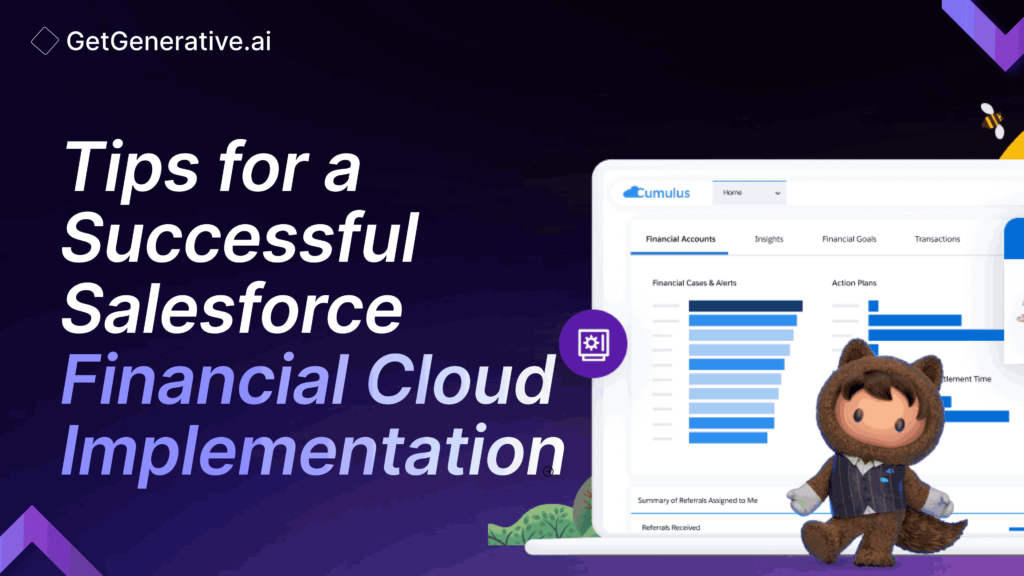Tips for a Successful Salesforce Financial Cloud Implementation
Implementing Salesforce Financial Cloud successfully requires strategic planning, careful execution, and continuous optimization.
This guide provides actionable tips to ensure your Salesforce Financial Cloud implementation is seamless and impactful.
1. Understand Your Business Needs
Before diving into the implementation process, it’s essential to define your organization’s goals and objectives.
- What problems are we trying to solve?
- How can Salesforce Financial Cloud align with our business strategy?
- Which processes need improvement or automation?
2. Choose the Right Implementation Partner
Look for Salesforce-certified experts with experience in financial services. They can help tailor the platform to your unique requirements, ensuring you maximize its potential while avoiding common pitfalls.
Key Considerations When Choosing a Partner:
- Expertise in the Industry
- Track record of successful implementations
- Commitment to offering support after deployment.
Also Read – Top Salesforce Implementation Partners in India 2024
3. Map Out a Clear Implementation Plan
Creating a roadmap is critical to staying on track. Break the implementation process into manageable phases, such as:
- Phase 1: Discovery and requirement gathering
- Phase 2: System design and customization
- Phase 3: Data migration and testing
- Phase 4: User training and deployment
A phased approach minimizes disruptions and ensures thorough execution.
4. Leverage Customization Features
Salesforce Financial Cloud comes with extensive customization options, enabling you to tailor the platform to fit seamlessly with your specific business operations. For example:
- Personalized Dashboards: Customize dashboards to display KPIs relevant to your organization.
- Automated Workflows: Streamline repetitive tasks like loan approvals or insurance claim tracking.
- Custom Objects: Create industry-specific data models, such as financial accounts or investment portfolios.
Tailoring these features ensures the platform works for you—not the other way around.
5. Focus on Data Quality During Migration
Shifting data to Salesforce Financial Cloud requires meticulous attention. It’s essential to ensure your data is accurate, consistent, and complete prior to migration.
Best Practices for Data Migration:
- Eliminate duplicate and outdated information.
- Standardize formats for data like contact details and addresses.
- Apply data validation rules to maintain accuracy.
Maintaining clean and organized data improves system performance and boosts user trust in the platform.
6. Provide Comprehensive Training
Your team’s ability to use Salesforce Financial Cloud effectively is vital for success. Invest in role-specific training sessions to ensure everyone—from executives to customer-facing staff—understands how to leverage the platform.
Tips for Effective Training:
- Use Salesforce Trailhead for self-paced learning.
- Conduct interactive workshops.
- Provide detailed user manuals and video tutorials.
Empowered users are more likely to adopt the system and use it to its full potential.
7. Involve Stakeholders Early
Engaging stakeholders from the beginning builds a sense of ownership and fosters enthusiasm. Include representatives from all departments, including sales, customer service, and IT, to gather diverse perspectives and ensure the solution meets organizational needs.
Benefits of Stakeholder Involvement:
- Encourages user adoption
- Ensures alignment with business objectives
- Identifies potential roadblocks early
8. Run Rigorous Tests
Conducting thorough testing before going live is non-negotiable. Simulate practical use cases to uncover and resolve potential issues, ensuring smooth system performance.
Types of Testing:
- Unit Testing: Verify individual components work as designed.
- Integration Testing: Confirm that the platform integrates effortlessly with other tools, such as accounting software.
- User Acceptance Testing (UAT): Allow end-users to interact with the system and share feedback to identify areas for improvement.
Thorough testing minimizes surprises and ensures a smooth launch.
9. Ensure a Smooth Deployment
The deployment phase is pivotal in determining the overall success of the Salesforce Financial Cloud implementation. Plan your go-live carefully to minimize disruptions to daily operations.
Tips for Deployment:
- Choose a low-activity period for the go-live.
- During the early post-deployment period, offer direct support.
- Closely monitor system performance to resolve any emerging challenges quickly.
10. Monitor and Optimize Post-Implementation
The work doesn’t end after deployment. Conduct regular evaluations of the system’s performance, gathering user feedback to pinpoint and address areas requiring enhancement.
Key Post-Implementation Practices:
- Conduct quarterly system audits.
- Stay updated with Salesforce’s latest features and upgrades.
- Utilize Salesforce support resources for troubleshooting and optimization.
Also Read – Key Features of Salesforce Financial Services Cloud
11. Stay Updated with Upgrades
Salesforce releases regular updates that introduce new features and enhancements. Keeping up with the latest Salesforce updates allows you to leverage new tools and features, ensuring your platform remains innovative and efficient.
How to Manage Updates:
- Review release notes to understand new features.
- Train users on relevant updates.
- Work with your implementation partner to implement changes effectively.
12. Foster a Culture of Adoption
Transitioning from legacy systems can be challenging for teams. Encourage innovation by:
- Highlighting the advantages of Salesforce Financial Cloud.
- Recognizing and celebrating small wins during the adoption phase.
- Providing ongoing training and support to empower users.
A supportive environment encourages users to adopt the platform wholeheartedly.
13. Utilize Salesforce’s Support Ecosystem
Salesforce offers a wealth of resources to help you succeed, including:
- Online documentation and knowledge base
- Trailhead learning modules
- Community forums and user groups
Leverage these resources to address challenges and maximize your investment.
14. Partner with Experts for Long-Term Success
If managing the platform becomes overwhelming, consider partnering with a Salesforce consultant. They can offer strategic guidance, refine configurations, and ensure your Salesforce Financial Cloud evolves alongside your business needs.
15. Tracking and Optimizing
Monitor your progress by measuring KPIs such as customer satisfaction, user adoption rates, and operational efficiency. Use these insights to refine strategies and maximize platform impact.
Also Read – Salesforce CRM Implementation With AI – The Ultimate Guide
Conclusion
Implementing Salesforce Financial Cloud is a transformative step for financial institutions, but its success hinges on proper planning, execution, and post-launch support. Adopting these strategies helps you capitalize on Salesforce Financial Cloud’s capabilities, optimize processes, and deliver superior customer experiences.
To learn more, visit GetGenerative.ai.




